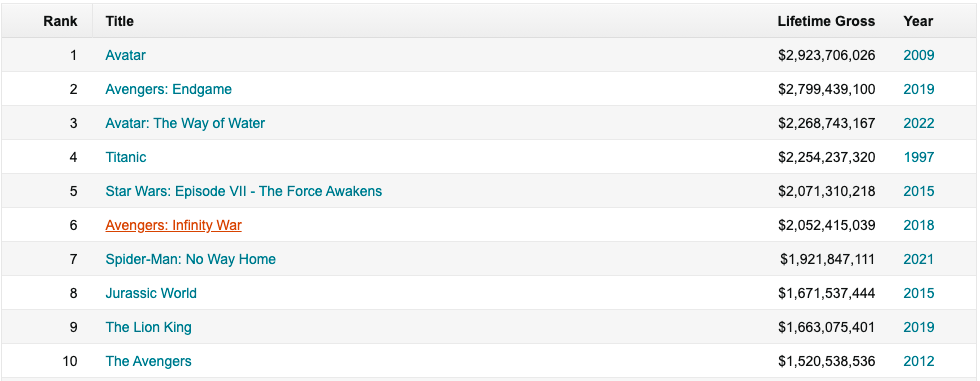Jurassic Park, Terminator, Mission Impossible, James Bond, Fast and Furious, Star Wars, Pirates of the Caribbean, The MCU, The DCU, Transformers, Lord of the Rings, the number of major movie franchises seems to grow larger and larger with each passing year. Stale ideas being remixed and recast until the final product has only a small shred of its original identity.
These movies make the majority of money in theaters, and film studios have relied on the safe success of franchises for a long time now, overshadowing the myriad of unique ideas and fresh topics that smaller films explore. So with the entire film industry facing the challenges of streaming, overcoming COVID, and higher ticket prices, franchises offer a safe outlet for millions of dollars to be invested with a somewhat guaranteed return.
Safety in Familiarity
Why are franchises so “safe”? The answer comes in a few forms. The first of which requires some background on the philosophy of movies and why people go to see them. Movies are an entertainment of spectacle. Going to a huge theater with hundreds of seats to watch an engaging story play out is inherently spectacular. It glorifies the films, literally showing them as larger than life, an aspect of watching that you lose when streaming on a small screen. And over the years movies themselves have gotten more and more spectacular, with higher stakes and more outlandish fantastical elements. A small grounded story just won’t fill the seats anymore, especially when compared to a bombastic star studded blockbuster.
The best indication of this shift is the success of the Marvel Cinematic Universe, which has quickly become the highest grossing movie franchise of all time. These movies consistently make more money in theaters than any other competing film and come equipped with hundreds of million dollar budgets and marketing campaigns. These films are the pinnacle of spectacle. The characters are super powered gods granted the power of CGI and name recognition that will stop at nothing to saturate the market and take all of the attention for themselves. Superhero movies alone account for one quarter of all theater revenue, which is an insane amount of market saturation for just one genre.
Built-in Audiences
The reason for this sheds some light on why franchises as a whole are so powerful. A crucial aspect of their success is the idea of a built in audience. Marvel movies are unique in this aspect, and have a sort of superpower of their own when it comes to built-in audiences. So a better example would be the recent Dune film adaptation.

Photo by CDD20 via Pixabay
Dune is a very popular book series that has many dedicated fans, and a portion of those fans would be guaranteed to see the movie in theaters purely out of franchise loyalty. Now, to further guarantee that even more people actually go to see Dune, which is a lengthy sci fi epic with many unwieldy themes and ideas, it would have to be filled with recognizable stars. Stars bring their own fans and name recognition, bringing a sense of credibility and importance to the film while adding to the growing guaranteed audience. This is clearly no secret, as famous actors have been fueling ticket sales since the beginning of cinema.
Now what if Dune made enough money to help justify the costs of a sequel. The sequel would come equipped with an even larger built-in audience. With each new film in the franchise new fans are drawn in and can be reliably added to the guaranteed audience. This is why so many franchises snowball and become generic imitations of their source material. As their audience grows, there is a need for broader appeal, which may contradict the creative intentions of the source material. In the case of the Dune sequel, however, the original story of the book was segmented into two films. This is another strategy that has been used to mixed results. Harry Potter, The Hobbit, even The Hunger Games have had their stories stretched out to accompany an additional film, or in the case of the Hobbit, three mediocre expansions. It isn’t enough to just make one movie out of a famous franchise, there must be more opportunities for profit wherever they can be found.
This is what happened with Dune 2021, which until then was considered to be “unfilmable” and had only seen the screen in the overly convoluted and directionless 1984 David Lynch film, which was widely regarded as a total financial and creative failure. Personally I think it makes sense to split up the lengthy story into two films, but it is also a very clear attempt to squeeze the franchise for everything it’s got.
So with a star studded cast, recognizable sci fi director, and 165 million US dollars this “unfilmable” movie had become yet another Hollywood blockbuster. Even when the subject matter of a story is seen as “impossible” to film, the guarantee of a built in audience will assuage any fears of failure. And in an industry that routinely gambles on hundred million dollar budgets, any guarantee of a return is extremely valuable.
A Cinema of Spectacle
So what advantage do Marvel movies have over the other major franchises? Well to start all of their stories and characters already have fans. Comic books are incredibly popular and have told the many stories of superheroes time and time again, through different illustrators and authors over the course of decades. Their audience has been growing since the first Marvel comic in 1939. Generations of fans have guaranteed that these movies will be popular, and their success is partially due to the nostalgic power they have. Their lasting success, however, has different origins. Marvel movies also popularized the idea of end credit scenes and multi character franchises. Instead of simply setting up a sequel, Marvel movies set up entire sagas, with multiple character origin stories to explore separately and then join together in big ensemble movies. Each movie builds excitement for the next until the plots and characters converge for one large amusement park of a movie.

Image from BoxOfficeMojo.
Luckily, the tide may be turning. Recently these huge franchise movies have been underperforming. Perhaps the same things that have caused a financial reliance on franchises (streaming, loss of physical purchases etc.) have finally started to wear down the juggernauts keeping the industry alive. Or maybe people are just tired of the 6th or 7th version of the same movie being reanimated by passionless studio execs.
Franchises are quickly growing stale, with each new reboot receiving less attention as sequels climb to the double digits. And as the landscape of the digital world develops more and more forms of entertainment emerge, from YouTube videos to Tik-Toks, even Netflix will inevitably compete with the theater movie industry.
It is my hope that we will see a resurgence of the clever medium budget movies that thrived in the 80s and 90s, with the occasional hundred million dollar excursion, but the future landscape of cinema remains to be seen.
Either way, the film industry is at a crossroads. Only time will tell what happens to franchises and the studios who obsess over them, but I for one am excited for the much needed change of pace.